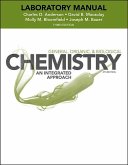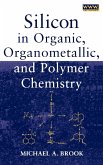Kenneth W Raymond
General, Organic, and Biological Chemistry: An Integrated Approach, 4e Student Solutions Manual
Kenneth W Raymond
General, Organic, and Biological Chemistry: An Integrated Approach, 4e Student Solutions Manual
- Broschiertes Buch
- Merkliste
- Auf die Merkliste
- Bewerten Bewerten
- Teilen
- Produkt teilen
- Produkterinnerung
- Produkterinnerung
General, Organic and Biological Chemistry, 4th Edition has been written for students preparing for careers in health-related fields such as nursing, dental hygiene, nutrition, medical technology and occupational therapy. It is also suited for students majoring in other fields where it is important to have an understanding of the basics of chemistry. An integrated approach is employed in which related general chemistry, organic chemistry, and biochemistry topics are presented in adjacent chapters. This approach helps students see the strong connections that exist between these three branches of…mehr
Andere Kunden interessierten sich auch für
![Laboratory Experiments to Accompany General, Organic and Biological Chemistry Laboratory Experiments to Accompany General, Organic and Biological Chemistry]() Charles AndersonLaboratory Experiments to Accompany General, Organic and Biological Chemistry137,99 €
Charles AndersonLaboratory Experiments to Accompany General, Organic and Biological Chemistry137,99 €![Silicon in Organic, Organometallic, and Polymer Chemistry Silicon in Organic, Organometallic, and Polymer Chemistry]() Michael A. BrookSilicon in Organic, Organometallic, and Polymer Chemistry320,99 €
Michael A. BrookSilicon in Organic, Organometallic, and Polymer Chemistry320,99 €![Lecture Notes on Fullerene Chemistry: A Handbook for Chemists Lecture Notes on Fullerene Chemistry: A Handbook for Chemists]() Roger TaylorLecture Notes on Fullerene Chemistry: A Handbook for Chemists100,99 €
Roger TaylorLecture Notes on Fullerene Chemistry: A Handbook for Chemists100,99 €![Organic Chemistry: The Basics Organic Chemistry: The Basics]() Organic Chemistry: The Basics151,99 €
Organic Chemistry: The Basics151,99 €![Organic Chemistry: Advanced Principles and Applications Organic Chemistry: Advanced Principles and Applications]() Organic Chemistry: Advanced Principles and Applications142,99 €
Organic Chemistry: Advanced Principles and Applications142,99 €![Organic Chemistry: Synthesis, Structures and Mechanisms Organic Chemistry: Synthesis, Structures and Mechanisms]() Organic Chemistry: Synthesis, Structures and Mechanisms143,99 €
Organic Chemistry: Synthesis, Structures and Mechanisms143,99 €![Organic Chemistry: Structure, Mechanism and Synthesis Organic Chemistry: Structure, Mechanism and Synthesis]() Organic Chemistry: Structure, Mechanism and Synthesis155,99 €
Organic Chemistry: Structure, Mechanism and Synthesis155,99 €-
-
-
General, Organic and Biological Chemistry, 4th Edition has been written for students preparing for careers in health-related fields such as nursing, dental hygiene, nutrition, medical technology and occupational therapy. It is also suited for students majoring in other fields where it is important to have an understanding of the basics of chemistry. An integrated approach is employed in which related general chemistry, organic chemistry, and biochemistry topics are presented in adjacent chapters. This approach helps students see the strong connections that exist between these three branches of chemistry, and allows instructors to discuss these, interrelationships while the material is still fresh in students′ minds.
Hinweis: Dieser Artikel kann nur an eine deutsche Lieferadresse ausgeliefert werden.
Hinweis: Dieser Artikel kann nur an eine deutsche Lieferadresse ausgeliefert werden.
Produktdetails
- Produktdetails
- Verlag: Wiley
- 4th edition
- Seitenzahl: 384
- Erscheinungstermin: 10. Dezember 2012
- Englisch
- Abmessung: 274mm x 213mm x 23mm
- Gewicht: 816g
- ISBN-13: 9781118362495
- ISBN-10: 1118362497
- Artikelnr.: 36268869
- Herstellerkennzeichnung
- Libri GmbH
- Europaallee 1
- 36244 Bad Hersfeld
- gpsr@libri.de
- Verlag: Wiley
- 4th edition
- Seitenzahl: 384
- Erscheinungstermin: 10. Dezember 2012
- Englisch
- Abmessung: 274mm x 213mm x 23mm
- Gewicht: 816g
- ISBN-13: 9781118362495
- ISBN-10: 1118362497
- Artikelnr.: 36268869
- Herstellerkennzeichnung
- Libri GmbH
- Europaallee 1
- 36244 Bad Hersfeld
- gpsr@libri.de
Kenneth W. Raymond is the author of Student Solutions Manual to accompany General Organic and Biological Chemistry, 4e, published by Wiley.
CHAPTER 1 SCIENCE AND MEASUREMENTS 1
1.1 The Scientific Method 2
1.2 Matter and Energy 5
1.3 Units of Measurement 9
1.4 Scientific Notation, SI and Metric Prefixes 13
1.5 Measurements and Significant Figures 15
1.6 Conversion Factors and the Factor Label Method 22
1.7 Density, Specific Gravity, and Specific Heat 25
1.8 Measurements in General Chemistry, Organic Chemistry, and Biochemistry
29
CHAPTER 2 ATOMS AND
2.1 Atoms 44
2.2 Elements 46
2.3 Trace Elements 48
2.4 Atomic Number and Mass Number 51
2.5 Periodic Table 54
2.6 The Mole 59
2.7 The Arrangement of Electrons 62
2.8 Radioactive Isotopes 68
2.9 Radioisotopes in Medicine 71
CHAPTER 3 COMPOUNDS 88
3.1 Ions 90
3.2 The Octet Rule 93
3.3 Ionic Compounds 96
3.4 Covalent Bonds 101
3.5 Molecules 103
3.6 Formula Weight, Molecular Weight, and Molar Mass 105
CHAPTER 4 AN INTRODUCTION TO ORGANIC COMPOUNDS 116
4.1 Structural Formulas 118
4.2 Polar Covalent Bonds, Shape, and Polarity 123
4.3 Noncovalent Interactions 130
4.4 Families of Organic Compounds 132
CHAPTER 5 REACTIONS 150
5.1 Chemical Equations 152
5.2 Reaction Types 156
5.3 Reactions Involving Water 158
5.4 Oxidation and Reduction 161
5.5 Mole and Mass Relationships in Reactions 167
5.6 Calculating the Yield of a Reaction 171
5.7 Free Energy and Reaction Rate 174
CHAPTER 6 GASES, SOLUTIONS, COLLOIDS, AND SUSPENSIONS 190
6.1 Gases and Pressure 192
6.2 The Gas Laws 197
6.3 Partial Pressure 202
6.4 Solutions 204
6.5 Precipitation Reactions 207
6.6 Solubility of Gases in Water 209
6.7 Organic and Biochemical Compounds 212
6.8 Concentration 216
6.9 Dilution 221
6.10 Colloids and Suspensions 222
6.11 Diffusion and Osmosis 225
CHAPTER 7 ACIDS, BASES, AND EQUILIBRIUM 238
7.1 Acids and Bases 240
7.2 Brønsted-Lowry Acids and Bases 241
7.3 Equilibrium 243
7.4 Le Châtelier's Principle 246
7.5 Ionization of Water 250
7.6 The pH Scale 251
7.7 Acid and Base Strength 254
7.8 Neutralizing Acids and Bases 257
7.9 Effect of pH on Acid and Conjugate Base Concentrations 259
7.10 Buffers 261
7.11 Maintaining the pH of Blood Serum 263
CHAPTER 8 ORGANIC REACTIONS 1-HYDROCARBONS, CARBOXYLIC ACIDS, AMINES, AND
RELATED COMPOUNDS 276
8.1 Alkanes 278
8.2 Constitutional Isomers 282
8.3 Conformations 284
8.4 Cycloalkanes 285
8.5 Alkenes, Alkynes, and Aromatic Compounds 287
8.6 Reactions of Hydrocarbons 291
8.7 Carboxylic Acids 297
8.8 Phenols 299
8.9 Carboxylic Acids and Phenols as Weak Organic Acids 301
8.10 Preparing Esters 304
8.11 Amines 307
8.12 Amines as Weak Organic Bases 311
8.13 Amides 313
ORGANIC REACTIONS 2-ALCOHOLS, ETHERS,ALDEHYDES, AND KETONES 334
9.1 Alcohols, Ethers, and Related Compounds 336
9.2 Preparation 339
9.3 Reactions 341
9.4 Aldehydes and Ketones 344
9.5 Oxidation of Aldehydes 347
9.6 Reduction of Aldehydes and Ketones 349
9.7 Reactions of Alcohols with Aldehydes and Ketones 352
CHAPTER 10 CARBOHYDRATES 370
10.1 Monosaccharides 372
10.2 Stereoisomers 374
10.3 Important Monosaccharides and Monosaccharide Derivatives 381
10.4 Reactions of Monosaccharides 384
10.5 Monosaccharides in Their Cyclic Form 386
10.6 Oligosaccharides 390
10.7 Polysaccharides 401
CHAPTER 11 LIPIDS AND MEMBRANES 420
11.1 Fatty Acids 422
11.2 Waxes 427
11.3 Triglycerides 429
11.4 Phospholipids and Glycolipids 437
11.5 Steroids 441
11.6 Eicosanoids 445
11.7 Membranes 447
CHAPTER 12 PEPTIDES, PROTEINS, AND ENZYMES 458
12.1 Amino Acids 460
12.2 The Peptide Bond 464
12.3 Peptides, Proteins, and pH 468
12.4 Protein Structure 469
12.5 Denaturation 477
12.6 Enzymes 478
12.7 Control of Enzyme-Catalyzed Reactions 482
CHAPTER 13 NUCLEIC ACIDS 498
13.1 Nucleic Acid Building Blocks 500
13.2 Nucleoside Di- and Triphosphates, Cyclic Nucleotides 505
13.3 Polynucleotides 506
13.4 DNA Structure 509
13.5 Denaturation 512
13.6 Nucleic Acids and Information Flow 514
13.7 DNA Replication 515
13.8 Transcription and RNA 517
13.9 Translation 520
13.10 Control of Gene Expression 522
13.11 Mutation 524
13.12 Recombinant DNA 525
13.13 DNA Fingerprinting 529
CHAPTER 14 METABOLISM 540
14.1 Metabolic Pathways, Energy, and Coupled Reactions 542
14.2 Overview of Metabolism 543
14.3 Digestion 548
14.4 Glycolysis 551
14.5 Gluconeogenesis 556
14.6 Glycogen Metabolism 558
14.7 Citric Acid Cycle 560
14.8 Electron Transport Chain and Oxidative Phosphorylation 562
14.9 Lipid Metabolism 566
14.10 Amino Acid Metabolism 571
Appendix A Important Families of Organic Compounds 582
Appendix B Naming Ions, Ionic Compounds, Binary Molecules, and Organic
Compounds 584
Appendix C Answers to Odd-Numbered Problems 591
Appendix D Glossary 639
Index I
1.1 The Scientific Method 2
1.2 Matter and Energy 5
1.3 Units of Measurement 9
1.4 Scientific Notation, SI and Metric Prefixes 13
1.5 Measurements and Significant Figures 15
1.6 Conversion Factors and the Factor Label Method 22
1.7 Density, Specific Gravity, and Specific Heat 25
1.8 Measurements in General Chemistry, Organic Chemistry, and Biochemistry
29
CHAPTER 2 ATOMS AND
2.1 Atoms 44
2.2 Elements 46
2.3 Trace Elements 48
2.4 Atomic Number and Mass Number 51
2.5 Periodic Table 54
2.6 The Mole 59
2.7 The Arrangement of Electrons 62
2.8 Radioactive Isotopes 68
2.9 Radioisotopes in Medicine 71
CHAPTER 3 COMPOUNDS 88
3.1 Ions 90
3.2 The Octet Rule 93
3.3 Ionic Compounds 96
3.4 Covalent Bonds 101
3.5 Molecules 103
3.6 Formula Weight, Molecular Weight, and Molar Mass 105
CHAPTER 4 AN INTRODUCTION TO ORGANIC COMPOUNDS 116
4.1 Structural Formulas 118
4.2 Polar Covalent Bonds, Shape, and Polarity 123
4.3 Noncovalent Interactions 130
4.4 Families of Organic Compounds 132
CHAPTER 5 REACTIONS 150
5.1 Chemical Equations 152
5.2 Reaction Types 156
5.3 Reactions Involving Water 158
5.4 Oxidation and Reduction 161
5.5 Mole and Mass Relationships in Reactions 167
5.6 Calculating the Yield of a Reaction 171
5.7 Free Energy and Reaction Rate 174
CHAPTER 6 GASES, SOLUTIONS, COLLOIDS, AND SUSPENSIONS 190
6.1 Gases and Pressure 192
6.2 The Gas Laws 197
6.3 Partial Pressure 202
6.4 Solutions 204
6.5 Precipitation Reactions 207
6.6 Solubility of Gases in Water 209
6.7 Organic and Biochemical Compounds 212
6.8 Concentration 216
6.9 Dilution 221
6.10 Colloids and Suspensions 222
6.11 Diffusion and Osmosis 225
CHAPTER 7 ACIDS, BASES, AND EQUILIBRIUM 238
7.1 Acids and Bases 240
7.2 Brønsted-Lowry Acids and Bases 241
7.3 Equilibrium 243
7.4 Le Châtelier's Principle 246
7.5 Ionization of Water 250
7.6 The pH Scale 251
7.7 Acid and Base Strength 254
7.8 Neutralizing Acids and Bases 257
7.9 Effect of pH on Acid and Conjugate Base Concentrations 259
7.10 Buffers 261
7.11 Maintaining the pH of Blood Serum 263
CHAPTER 8 ORGANIC REACTIONS 1-HYDROCARBONS, CARBOXYLIC ACIDS, AMINES, AND
RELATED COMPOUNDS 276
8.1 Alkanes 278
8.2 Constitutional Isomers 282
8.3 Conformations 284
8.4 Cycloalkanes 285
8.5 Alkenes, Alkynes, and Aromatic Compounds 287
8.6 Reactions of Hydrocarbons 291
8.7 Carboxylic Acids 297
8.8 Phenols 299
8.9 Carboxylic Acids and Phenols as Weak Organic Acids 301
8.10 Preparing Esters 304
8.11 Amines 307
8.12 Amines as Weak Organic Bases 311
8.13 Amides 313
ORGANIC REACTIONS 2-ALCOHOLS, ETHERS,ALDEHYDES, AND KETONES 334
9.1 Alcohols, Ethers, and Related Compounds 336
9.2 Preparation 339
9.3 Reactions 341
9.4 Aldehydes and Ketones 344
9.5 Oxidation of Aldehydes 347
9.6 Reduction of Aldehydes and Ketones 349
9.7 Reactions of Alcohols with Aldehydes and Ketones 352
CHAPTER 10 CARBOHYDRATES 370
10.1 Monosaccharides 372
10.2 Stereoisomers 374
10.3 Important Monosaccharides and Monosaccharide Derivatives 381
10.4 Reactions of Monosaccharides 384
10.5 Monosaccharides in Their Cyclic Form 386
10.6 Oligosaccharides 390
10.7 Polysaccharides 401
CHAPTER 11 LIPIDS AND MEMBRANES 420
11.1 Fatty Acids 422
11.2 Waxes 427
11.3 Triglycerides 429
11.4 Phospholipids and Glycolipids 437
11.5 Steroids 441
11.6 Eicosanoids 445
11.7 Membranes 447
CHAPTER 12 PEPTIDES, PROTEINS, AND ENZYMES 458
12.1 Amino Acids 460
12.2 The Peptide Bond 464
12.3 Peptides, Proteins, and pH 468
12.4 Protein Structure 469
12.5 Denaturation 477
12.6 Enzymes 478
12.7 Control of Enzyme-Catalyzed Reactions 482
CHAPTER 13 NUCLEIC ACIDS 498
13.1 Nucleic Acid Building Blocks 500
13.2 Nucleoside Di- and Triphosphates, Cyclic Nucleotides 505
13.3 Polynucleotides 506
13.4 DNA Structure 509
13.5 Denaturation 512
13.6 Nucleic Acids and Information Flow 514
13.7 DNA Replication 515
13.8 Transcription and RNA 517
13.9 Translation 520
13.10 Control of Gene Expression 522
13.11 Mutation 524
13.12 Recombinant DNA 525
13.13 DNA Fingerprinting 529
CHAPTER 14 METABOLISM 540
14.1 Metabolic Pathways, Energy, and Coupled Reactions 542
14.2 Overview of Metabolism 543
14.3 Digestion 548
14.4 Glycolysis 551
14.5 Gluconeogenesis 556
14.6 Glycogen Metabolism 558
14.7 Citric Acid Cycle 560
14.8 Electron Transport Chain and Oxidative Phosphorylation 562
14.9 Lipid Metabolism 566
14.10 Amino Acid Metabolism 571
Appendix A Important Families of Organic Compounds 582
Appendix B Naming Ions, Ionic Compounds, Binary Molecules, and Organic
Compounds 584
Appendix C Answers to Odd-Numbered Problems 591
Appendix D Glossary 639
Index I
CHAPTER 1 SCIENCE AND MEASUREMENTS 1
1.1 The Scientific Method 2
1.2 Matter and Energy 5
1.3 Units of Measurement 9
1.4 Scientific Notation, SI and Metric Prefixes 13
1.5 Measurements and Significant Figures 15
1.6 Conversion Factors and the Factor Label Method 22
1.7 Density, Specific Gravity, and Specific Heat 25
1.8 Measurements in General Chemistry, Organic Chemistry, and Biochemistry
29
CHAPTER 2 ATOMS AND
2.1 Atoms 44
2.2 Elements 46
2.3 Trace Elements 48
2.4 Atomic Number and Mass Number 51
2.5 Periodic Table 54
2.6 The Mole 59
2.7 The Arrangement of Electrons 62
2.8 Radioactive Isotopes 68
2.9 Radioisotopes in Medicine 71
CHAPTER 3 COMPOUNDS 88
3.1 Ions 90
3.2 The Octet Rule 93
3.3 Ionic Compounds 96
3.4 Covalent Bonds 101
3.5 Molecules 103
3.6 Formula Weight, Molecular Weight, and Molar Mass 105
CHAPTER 4 AN INTRODUCTION TO ORGANIC COMPOUNDS 116
4.1 Structural Formulas 118
4.2 Polar Covalent Bonds, Shape, and Polarity 123
4.3 Noncovalent Interactions 130
4.4 Families of Organic Compounds 132
CHAPTER 5 REACTIONS 150
5.1 Chemical Equations 152
5.2 Reaction Types 156
5.3 Reactions Involving Water 158
5.4 Oxidation and Reduction 161
5.5 Mole and Mass Relationships in Reactions 167
5.6 Calculating the Yield of a Reaction 171
5.7 Free Energy and Reaction Rate 174
CHAPTER 6 GASES, SOLUTIONS, COLLOIDS, AND SUSPENSIONS 190
6.1 Gases and Pressure 192
6.2 The Gas Laws 197
6.3 Partial Pressure 202
6.4 Solutions 204
6.5 Precipitation Reactions 207
6.6 Solubility of Gases in Water 209
6.7 Organic and Biochemical Compounds 212
6.8 Concentration 216
6.9 Dilution 221
6.10 Colloids and Suspensions 222
6.11 Diffusion and Osmosis 225
CHAPTER 7 ACIDS, BASES, AND EQUILIBRIUM 238
7.1 Acids and Bases 240
7.2 Brønsted-Lowry Acids and Bases 241
7.3 Equilibrium 243
7.4 Le Châtelier's Principle 246
7.5 Ionization of Water 250
7.6 The pH Scale 251
7.7 Acid and Base Strength 254
7.8 Neutralizing Acids and Bases 257
7.9 Effect of pH on Acid and Conjugate Base Concentrations 259
7.10 Buffers 261
7.11 Maintaining the pH of Blood Serum 263
CHAPTER 8 ORGANIC REACTIONS 1-HYDROCARBONS, CARBOXYLIC ACIDS, AMINES, AND
RELATED COMPOUNDS 276
8.1 Alkanes 278
8.2 Constitutional Isomers 282
8.3 Conformations 284
8.4 Cycloalkanes 285
8.5 Alkenes, Alkynes, and Aromatic Compounds 287
8.6 Reactions of Hydrocarbons 291
8.7 Carboxylic Acids 297
8.8 Phenols 299
8.9 Carboxylic Acids and Phenols as Weak Organic Acids 301
8.10 Preparing Esters 304
8.11 Amines 307
8.12 Amines as Weak Organic Bases 311
8.13 Amides 313
ORGANIC REACTIONS 2-ALCOHOLS, ETHERS,ALDEHYDES, AND KETONES 334
9.1 Alcohols, Ethers, and Related Compounds 336
9.2 Preparation 339
9.3 Reactions 341
9.4 Aldehydes and Ketones 344
9.5 Oxidation of Aldehydes 347
9.6 Reduction of Aldehydes and Ketones 349
9.7 Reactions of Alcohols with Aldehydes and Ketones 352
CHAPTER 10 CARBOHYDRATES 370
10.1 Monosaccharides 372
10.2 Stereoisomers 374
10.3 Important Monosaccharides and Monosaccharide Derivatives 381
10.4 Reactions of Monosaccharides 384
10.5 Monosaccharides in Their Cyclic Form 386
10.6 Oligosaccharides 390
10.7 Polysaccharides 401
CHAPTER 11 LIPIDS AND MEMBRANES 420
11.1 Fatty Acids 422
11.2 Waxes 427
11.3 Triglycerides 429
11.4 Phospholipids and Glycolipids 437
11.5 Steroids 441
11.6 Eicosanoids 445
11.7 Membranes 447
CHAPTER 12 PEPTIDES, PROTEINS, AND ENZYMES 458
12.1 Amino Acids 460
12.2 The Peptide Bond 464
12.3 Peptides, Proteins, and pH 468
12.4 Protein Structure 469
12.5 Denaturation 477
12.6 Enzymes 478
12.7 Control of Enzyme-Catalyzed Reactions 482
CHAPTER 13 NUCLEIC ACIDS 498
13.1 Nucleic Acid Building Blocks 500
13.2 Nucleoside Di- and Triphosphates, Cyclic Nucleotides 505
13.3 Polynucleotides 506
13.4 DNA Structure 509
13.5 Denaturation 512
13.6 Nucleic Acids and Information Flow 514
13.7 DNA Replication 515
13.8 Transcription and RNA 517
13.9 Translation 520
13.10 Control of Gene Expression 522
13.11 Mutation 524
13.12 Recombinant DNA 525
13.13 DNA Fingerprinting 529
CHAPTER 14 METABOLISM 540
14.1 Metabolic Pathways, Energy, and Coupled Reactions 542
14.2 Overview of Metabolism 543
14.3 Digestion 548
14.4 Glycolysis 551
14.5 Gluconeogenesis 556
14.6 Glycogen Metabolism 558
14.7 Citric Acid Cycle 560
14.8 Electron Transport Chain and Oxidative Phosphorylation 562
14.9 Lipid Metabolism 566
14.10 Amino Acid Metabolism 571
Appendix A Important Families of Organic Compounds 582
Appendix B Naming Ions, Ionic Compounds, Binary Molecules, and Organic
Compounds 584
Appendix C Answers to Odd-Numbered Problems 591
Appendix D Glossary 639
Index I
1.1 The Scientific Method 2
1.2 Matter and Energy 5
1.3 Units of Measurement 9
1.4 Scientific Notation, SI and Metric Prefixes 13
1.5 Measurements and Significant Figures 15
1.6 Conversion Factors and the Factor Label Method 22
1.7 Density, Specific Gravity, and Specific Heat 25
1.8 Measurements in General Chemistry, Organic Chemistry, and Biochemistry
29
CHAPTER 2 ATOMS AND
2.1 Atoms 44
2.2 Elements 46
2.3 Trace Elements 48
2.4 Atomic Number and Mass Number 51
2.5 Periodic Table 54
2.6 The Mole 59
2.7 The Arrangement of Electrons 62
2.8 Radioactive Isotopes 68
2.9 Radioisotopes in Medicine 71
CHAPTER 3 COMPOUNDS 88
3.1 Ions 90
3.2 The Octet Rule 93
3.3 Ionic Compounds 96
3.4 Covalent Bonds 101
3.5 Molecules 103
3.6 Formula Weight, Molecular Weight, and Molar Mass 105
CHAPTER 4 AN INTRODUCTION TO ORGANIC COMPOUNDS 116
4.1 Structural Formulas 118
4.2 Polar Covalent Bonds, Shape, and Polarity 123
4.3 Noncovalent Interactions 130
4.4 Families of Organic Compounds 132
CHAPTER 5 REACTIONS 150
5.1 Chemical Equations 152
5.2 Reaction Types 156
5.3 Reactions Involving Water 158
5.4 Oxidation and Reduction 161
5.5 Mole and Mass Relationships in Reactions 167
5.6 Calculating the Yield of a Reaction 171
5.7 Free Energy and Reaction Rate 174
CHAPTER 6 GASES, SOLUTIONS, COLLOIDS, AND SUSPENSIONS 190
6.1 Gases and Pressure 192
6.2 The Gas Laws 197
6.3 Partial Pressure 202
6.4 Solutions 204
6.5 Precipitation Reactions 207
6.6 Solubility of Gases in Water 209
6.7 Organic and Biochemical Compounds 212
6.8 Concentration 216
6.9 Dilution 221
6.10 Colloids and Suspensions 222
6.11 Diffusion and Osmosis 225
CHAPTER 7 ACIDS, BASES, AND EQUILIBRIUM 238
7.1 Acids and Bases 240
7.2 Brønsted-Lowry Acids and Bases 241
7.3 Equilibrium 243
7.4 Le Châtelier's Principle 246
7.5 Ionization of Water 250
7.6 The pH Scale 251
7.7 Acid and Base Strength 254
7.8 Neutralizing Acids and Bases 257
7.9 Effect of pH on Acid and Conjugate Base Concentrations 259
7.10 Buffers 261
7.11 Maintaining the pH of Blood Serum 263
CHAPTER 8 ORGANIC REACTIONS 1-HYDROCARBONS, CARBOXYLIC ACIDS, AMINES, AND
RELATED COMPOUNDS 276
8.1 Alkanes 278
8.2 Constitutional Isomers 282
8.3 Conformations 284
8.4 Cycloalkanes 285
8.5 Alkenes, Alkynes, and Aromatic Compounds 287
8.6 Reactions of Hydrocarbons 291
8.7 Carboxylic Acids 297
8.8 Phenols 299
8.9 Carboxylic Acids and Phenols as Weak Organic Acids 301
8.10 Preparing Esters 304
8.11 Amines 307
8.12 Amines as Weak Organic Bases 311
8.13 Amides 313
ORGANIC REACTIONS 2-ALCOHOLS, ETHERS,ALDEHYDES, AND KETONES 334
9.1 Alcohols, Ethers, and Related Compounds 336
9.2 Preparation 339
9.3 Reactions 341
9.4 Aldehydes and Ketones 344
9.5 Oxidation of Aldehydes 347
9.6 Reduction of Aldehydes and Ketones 349
9.7 Reactions of Alcohols with Aldehydes and Ketones 352
CHAPTER 10 CARBOHYDRATES 370
10.1 Monosaccharides 372
10.2 Stereoisomers 374
10.3 Important Monosaccharides and Monosaccharide Derivatives 381
10.4 Reactions of Monosaccharides 384
10.5 Monosaccharides in Their Cyclic Form 386
10.6 Oligosaccharides 390
10.7 Polysaccharides 401
CHAPTER 11 LIPIDS AND MEMBRANES 420
11.1 Fatty Acids 422
11.2 Waxes 427
11.3 Triglycerides 429
11.4 Phospholipids and Glycolipids 437
11.5 Steroids 441
11.6 Eicosanoids 445
11.7 Membranes 447
CHAPTER 12 PEPTIDES, PROTEINS, AND ENZYMES 458
12.1 Amino Acids 460
12.2 The Peptide Bond 464
12.3 Peptides, Proteins, and pH 468
12.4 Protein Structure 469
12.5 Denaturation 477
12.6 Enzymes 478
12.7 Control of Enzyme-Catalyzed Reactions 482
CHAPTER 13 NUCLEIC ACIDS 498
13.1 Nucleic Acid Building Blocks 500
13.2 Nucleoside Di- and Triphosphates, Cyclic Nucleotides 505
13.3 Polynucleotides 506
13.4 DNA Structure 509
13.5 Denaturation 512
13.6 Nucleic Acids and Information Flow 514
13.7 DNA Replication 515
13.8 Transcription and RNA 517
13.9 Translation 520
13.10 Control of Gene Expression 522
13.11 Mutation 524
13.12 Recombinant DNA 525
13.13 DNA Fingerprinting 529
CHAPTER 14 METABOLISM 540
14.1 Metabolic Pathways, Energy, and Coupled Reactions 542
14.2 Overview of Metabolism 543
14.3 Digestion 548
14.4 Glycolysis 551
14.5 Gluconeogenesis 556
14.6 Glycogen Metabolism 558
14.7 Citric Acid Cycle 560
14.8 Electron Transport Chain and Oxidative Phosphorylation 562
14.9 Lipid Metabolism 566
14.10 Amino Acid Metabolism 571
Appendix A Important Families of Organic Compounds 582
Appendix B Naming Ions, Ionic Compounds, Binary Molecules, and Organic
Compounds 584
Appendix C Answers to Odd-Numbered Problems 591
Appendix D Glossary 639
Index I








